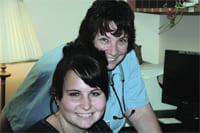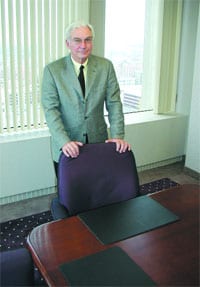Learning By Doing CDH Partners with Smith Voke in a Unique Internship Program
Katelynn Lampron spent a good part of her senior year in the hospital.
No, she wasn’t injured or sick; she was working. Every other week, she sat in academic classes at Smith Vocational High School. And on alternating weeks, she worked three 10-hour days as a certified nursing assistant at the hospital that borders the school’s property.
Considering they’re neighbors, Lisa-Lee Keith wonders why it took so long to bring students on board.
Lampron became a CNA in April 2008, during her junior year at Smith, and she was the one student chosen from her class for the new internship opportunity at Cooley Dickinson because of her excellent grades, skills, and work ethic.
“The question was, how can we partner with this vocational school that’s our geographic neighbor?” said Keith, CDH’s chief nursing officer and vice president of Patient Care Services. “I met with administrators at Smith and asked what we could do for high-school students on the health services track. They were very excited and selected the best and brightest student to be a part of the pilot and come over to do a co-op here at the hospital.”
Cooperative studies are common to vocational schools, Keith explained, and are generally undertaken during the junior and senior years.
“The school partners with professionals in the community. On the electrical service side, a student might work with an electrical contractor. Instead of a shop in school, they’re with the crew out on the road, like an employee, and they’re compensated for it. It gives them phenomenal work skills, gives them an real opportunity to experience the work world.”
Thus, Lampron became the first Smith student to experience the work culture at Cooley — in the fast-paced critical care unit, no less — but she certainly won’t be the last.
Meeting a Need
Keith explained that the partnership is a small part of a larger effort, being undertaken by health systems nationally, to address a nursing workforce shortage that promises to worsen as nurses from the Baby Boom generation begin to retire.
She understands the issue more than most as a member of a regional workforce development partnership for health care that works with hospitals, colleges, and the Mass. Department of Higher Education Economic Council to grapple with the scope of the nursing shortage and how it will impact care in the future.
The partnership has developed a state model to estimate the scope of the growing nursing workforce shortage between 2009 and 2020, estimate costs and resources needed to increase the capacity of schools, develop an economic cost model to identify and shape cost-effective approaches, and inform policy options to increase capacity of nursing education programs.
“This initiative demonstrates how we are being creative about workforce development,” she said. “We start with high-school students who know they want to work in health care, bring them into the hospital culture, and familiarize them with the surroundings and how things work, and help them build the skills they will need to succeed in their education as well as their clinical competencies.”
The collaboration between Cooley Dickinson and Smith Vocational was intended to create a bond that would encourage students to pursue their career goals in a clinical field, said Keith. And, indeed, while interning as a CNA, Lampron was influenced by the hospital staff and the health care environment to want to be a nurse.
“Katelynn was partnered with a registered nurse in the critical care unit, and that 16-year-old young lady and the nurse were together every other week,” Keith said. “She followed the nurse’s schedule and could work as a certified nursing assistant, but was immersed in the culture of the hospital and really mentored.
“She came back for her senior year, and she was treated like a hospital employee,” Keith added. “She was compensated by the hospital, she learned the entire computer system, how charts are organized, how to enter them into the computerized system … it’s just been a phenomenal experience here. Even though it was just a one-student pilot, she developed a good repertoire of skills, she feels comfortable, and she clearly knew by the time she graduated that she wanted to go to nursing school.”
After the internship was completed, Lampron continued to work per diem at the hospital before enrolling in the Nursing program at Holyoke Community College this fall. She’s also continuing to work in the hospital as a monitor tech in the Telemetry department.
A second junior came on board this past March for the second year of the program, and she’s following a similar track to Lampron’s now that she’s begun her senior year of studies and hospital work. CDH would like to bring on more than one student at a time in the future, but there are only 12 students on the health care track at Smith, and the hospital has high standards for the position.
“The ability to come into the acute-care setting is a privilege that not everybody gets. You’ve got to have a little more maturity than most,” said Keith. “There were three candidates last spring, and two decided they weren’t ready, and I’m thankful that the students were honest with us and themselves, knowing they weren’t ready for this level of commitment as a junior in high school.”
Big Picture
Although the nursing shortage has been in the public consciousness for some time, Keith said the worst may still be to come, because economic turmoil is keeping many older nurses at work longer than they might have planned. When they start to retire, though, there will be plenty of positions to fill. “The shortage is going to be there,” she said. “Investing in the young is well worth it in terms of the big picture.”
Although taking one student through the program at a time may not seem like much, she said, the partnership is about more than helping a few teenagers sort out their career goals.
“Both of us benefit,” she said. “They get the experience, and we get to be a part of something much bigger than ourselves. We get to give back to health care.”


